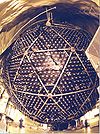- NEVOD
-
NEVOD (Russian: НЕВОД, НЕйтринный ВОдный Детектор, Neutrino Water Detector) is a neutrino detector and cosmic ray experiment that attempts to detect Cherenkov radiation arising from interactions between water and charged particles (mostly muons). It represents the first attempt to perform such measurements at the earth's surface; it is because of this surface deployment that the experiment is also able to investigate cosmic rays. NEVOD is situated at the Moscow Engineering Physics Institute (MEPhI).
Description
As described by its inventors,[1] NEVOD consists of a water reservoir measuring 9 m x 9 m x 26 m into which is placed a spatial lattice of quasi-spherical detector modules (QSMs) to record Cherenkov radiation from any direction. The dimensions of reservoir make it possible to arrange up to 241 QSMs.
The quasi-spherical modules are, in fact, not spherical, but consist of an array of 6 photomultiplier tubes arranged along the primary axes of the device. The arrangement of the PMTs is such that the response of the PMT is dependent only on the intensity of the incident radiation, but not on its angle of incidence (over the limitation of angles viewable by the device), rendering the entire detector "quasi-spherical".
History
NEVOD was first described in 1995,[1] and has since been used both for primary research and for educational purposes.[2]
References
- ^ a b Aynutdinov, V.M.; Kindin, V.V.; Kompaniets, K.G.; Petrukhin, A.A.; Tkachenko, P.V.; Shutenko, V.V.; Yashin1, I.I. (1997). "Neutrino Water Detector on the Earth's Surface". Astrophysics and Space Science 58 (1–2): 105. Bibcode 1997Ap&SS.258..105A. doi:10.1023/A:1001779122430.
- ^ "Experimental Complex NEVOD". NEVOD MEPhI. 2006. http://nevod.mephi.ru/English/index.htm/. Retrieved 2010-06-18.
Neutrino detectors, experiments, and facilities Discoveries 
Operating Construction Retired Proposed Cancelled See also Categories:- Neutrino observatories
- Neutrino astronomy
- Particle experiments
Wikimedia Foundation. 2010.
